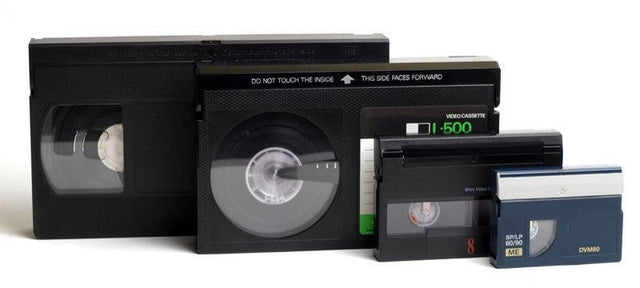If you’ve stumbled upon a box of old camcorder tapes—maybe from a family trip, a child’s first steps, or a long-forgotten holiday—you’re likely holding some of the most irreplaceable moments of your life. But camcorders have long vanished from shelves, and the tapes they recorded on are aging fast.
This guide will walk you through the different types of camcorder tapes, how to identify them, and how to convert camcorder tapes to digital—so your memories don’t get stuck in the past.
VHS Camcorder Tapes: The Original Home Movie Format
In the 1980s and ’90s, the VHS camcorder was the star of every birthday party and graduation. These bulky camcorders recorded straight onto standard VHS camcorder tapes, which are easy to recognize by their large size. If you’ve still got one lying around, consider yourself lucky—they’re becoming harder to find and even harder to fix.
Today, families looking to preserve these memories rely on an expert VHS tape to digital service, which ensures a high-quality transfer that’s easy to watch and share across modern devices.
Smaller Formats: VHS-C, 8mm, and MiniDV Tapes
Not all camcorder tapes are full-size VHS. Starting in the 1990s, manufacturers introduced more compact formats that made handheld recording easier.
- VHS-C Tapes: These are miniature versions of VHS tapes. They require a special VHS-C adapter to play in a standard VCR.
- 8mm and Hi8 Tapes: These were Sony’s answer to the compact video trend. Often labeled as Video8, Hi8, or Digital8, they require specific camcorders or players to view. Explore our 8mm to digital conversion options.
- MiniDV Tapes: The last of the camcorder tape generation, MiniDV offered better quality but only worked in DV-compatible camcorders. We offer MiniDV transfer services to help unlock that footage.
To help you sort out your collection, read our blog on unlocking old memories from camcorder tapes.

Why You Should Transfer Camcorder Tapes to Digital
Camcorder tapes weren’t designed to last. The magnetic tape inside degrades with time and use, especially when stored in attics or garages. Even if your tapes seem fine, most people no longer have the equipment to play them.
By choosing to transfer camcorder tapes to digital, you protect them from:
- Mold, dust, and heat damage
- Wear from outdated playback equipment
- Permanent loss due to deterioration or accidental disposal
Many families choose an America’s best video tape conversion service to get a secure digital copy. Some even opt for cloud access, which makes sharing memories as simple as sending a link.

What’s the Best Way to Convert Camcorder Tapes to Digital?
You have options, but not all are equal:
- DIY converters are cheap but often glitchy and low-quality.
- Big-box services may charge you upfront and reject tapes without refunds.
- Professionals ensure better handling, real-time previews, and extras like credit for blank tapes or cloud-based storage instead of outdated DVDs.
Look for a provider that treats your memories with the same care you would—and allows you to keep or download them on your terms.

FAQ: People Also Ask
Can camcorder tapes still be played today?
Yes, but it’s increasingly difficult. Most camcorder models that match specific tape formats (VHS-C, 8mm, Hi8, MiniDV) are no longer manufactured, and used ones are often unreliable. Even if you find a working camcorder or player, every playback risks damaging the fragile tape.
How long do camcorder tapes last before they degrade?
Camcorder tapes typically begin showing signs of degradation after 10–20 years, depending on how they were stored. Heat, humidity, and dust speed up this process. Even if the tape looks fine on the outside, the magnetic signal inside weakens over time, leading to fuzzy or unplayable footage.
What’s the difference between converting camcorder tapes to DVD vs. digital files?
DVDs were once a popular conversion choice, but they're prone to scratches and can become unreadable in a decade. Converting directly to digital files (like an MP4 on the cloud) provides longer-lasting preservation, easier sharing, and backup options that DVDs can’t match.
Can damaged camcorder tapes be repaired before transferring?
In many cases, yes. Professional digitizing companies can repair broken shells, re-spool tangled tape, and even clean mold. However, the tape should be handled by experts—DIY fixes often make the damage worse.
How much does it usually cost to convert camcorder tapes to digital?
Prices vary by provider and tape type, but most services charge between $15 and $35 per tape. Premium services may include extras like free tape repair, cloud storage, or discounts for bulk orders. It’s important to compare quality and features—not just price—before choosing.
Recommended Next Reads
Your Wedding Video Is Worth Watching Again
The History of Video: How We Captured Life One Frame at a Time
VCR Tapes Explained: Why They Break Down and How to Save Them
Best VHS Converter Options: Save Your Home Videos Before They Fade
What Is Nostalgia? The Science and Magic Behind Nostalgic Memories
📧 Want more tips like this?
Subscribe to Heirloom emails to learn how to preserve your priceless memories. Get discount codes for expedited shipping, quality digitizing, and secure cloud storage. We never spam, and it’s easy to unsubscribe at any time.


